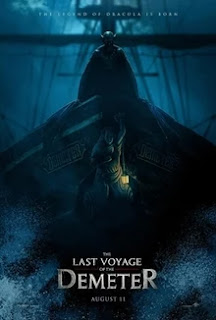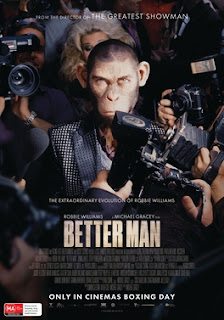The Last Voyage of the Demeter
The Last Voyage of the Demeter
Starring Corey Hawkins, Aisling Franciosi, Liam Cunningham, David Dastmalchian
Directed by Andre Ovredal
In 1897, a group of sailors embark from Transylvania to London carrying a load of cargo, one of which is the coffin of Dracula (Javier Botet) - although they don't know it. On board are Captain Elliot (Liam Cunningham), his first mate Wojchek (David Dastmalchian), his grandson Toby (Woody Norman), doctor Clemens (Corey Hawkins), and a few other crew members. Soon after embarking they discover a woman named Anna (Aisling Franciosi) who seemingly stowed away, and decide to keep her on board to save time so they can get a bonus for arriving in London early. Yet Anna isn't the only other being unaccounted for, as Dracula runs rampant at night, killing the livestock before stalking the crew, and with nowhere to run or hide, they find themselves either at the mercy of Dracula, or must find a way to prevent him from reaching the mainland.
The Good:
Andre Ovredal has a knack for establishing mood and tension with his tight enclosed spaces. "Jane Doe" takes place entirely in the basement of a morgue, and he utilizes that tight space to full effect as he provides scares aplenty along with a solidly written script. "Trollhunter" establishes the harsh landscapes of Norway in a way that feels restricted and confined. He does this once again with "Demeter," showcasing the hopeless feat that the crew endures as they're literally stuck on the ship with Dracula and nowhere to go. They can't just swim for it, or use the escape boats, because Dracula would follow them. They're stuck on the boat, and Ovredal uses the darkness, the elements, and even the harsh daylight to exhibit the terror that the men (and woman) faced. During a torrential downpour at night, Dracula is barely lit in the scene as he flies with superhuman speed from one side to the other as he dispatches the unwitting crew one by one, stalking them like Jason Voorhees stalks camp counselors. Yet here it's more hopeless - at least from our viewpoint, because since this film is based on a chapter of the widely acclaimed novel Dracula, we know that he'll eventually make his way off the boat and (more than likely) no one else will survive.
To that end they create a problem in the storytelling that's inherent from the start: we know the outcome, more or less, before the characters do. There's no real sense of satisfaction, as we know that the bad guy will ultimately win, or at least end in a draw, as Dracula is bound to wreak havoc in London by the end. To combat this, Ovredal once again uses the confined space and cinematography to keep the mood going. It's terrifying to see the outline of Dracula flying through a fog-infested sky, or his looming shadow growing ever so big as he slowly advances on his prey.
Then there's the practical effects, which I can wholly appreciate. Dracula isn't some CGI monstrosity that's laughably bad on screen, but rather it's an actor buried under layers of prosthetics and makeup, like the good ole days. Javier Botet is an acclaimed creature actor who played the titular Mama in "Mama," the Tristana Medeiros creature in the "Rec" series, and The Crooked Man in "The Conjuring 2" among others, so he was a natural fit to play this non-sparkling vampire. He is downright terrifying not just from the shadows, but when you see him fully as well. It's a throwback to the classic creature feature that's sorely missing nowadays.
The film lives up to its R rating with the gore coming in buckets, as necks get slashed and sucked on, and bodies get thrown around like rag dolls. The wood panels of the ship drip with blood, and bodies burn with sheer intensity. It's a gorehound's delight, delivered to perfection.
The Bad:
The story tends to drag for most of the film, as the majority of the time the people are talking about what's happening and how to stop it over and over, like Groundhog Day. It's weird because one night Clemens finds Dracula's coffin, and then they plan to kill it without going back to the coffin during the day, opening it up and driving a steak through its heart. Of course, again, this is from the audiences' minds who grew up knowing how to take him down, and the characters have no idea who he really is, not even Anna, who Dracula was feasting on when she was brought on board.
The film is almost two hours long, and a good thirty minutes could've been cropped for a better outcome. While it was cool seeing Dracula in his element, the other scenes where there's no character development but instead the crew freaking out over and over could've been cut. As it is, it turned the movie into something of a bore as you take a quick nap while you wait until night for Dracula to strike again - and you won't miss anything in the interim.
Corey Hawkins is one of the most underrated actors of today's generation, but not even he could rise above the monotony of his script. Apart from a real moment where he talks about being a black man trying to get a job after graduating Cambridge, his role is effectively to be the center of attention as the events unfold around him, muttering that he doesn't believe in such superstitions but relies on fact - until he sees Dracula and tries to use reason to kill him. He doesn't get much else to work with here, and neither do the other actors who merely exist as the tropes for such a film. Aisling Franciosi (who ruled the screen in "The Nightingale") serves as the exposition dump, Liam Cunningham is the traditional ship captain, and David Dastmalchian is sidelined as the cocky, arrogant first mate. No one has any character development, and it makes the audience not really care about their ultimate fates.
The Verdict:
If the film was cut shorter and the characters given more to their story, "The Last Voyage of the Demeter" could've been a stellar throwback to the classic creature features of old, but since it overstays its welcome and doesn't give the actors a lot to do other than eventually die, it just coasts through its bloated runtime with very little left to be remembered for.
The Score: B-




Comments
Post a Comment